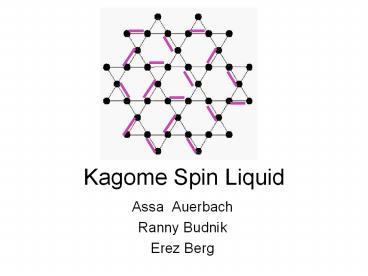Kagome Spin Liquid PowerPoint PPT Presentation
1 / 31
Title: Kagome Spin Liquid
1
Kagome Spin Liquid
- Assa Auerbach
- Ranny Budnik
- Erez Berg
2
Classical Heisenberg AFM
3
Experiments
S3/2 layered Kagome
90
Strong quantum spin fluctuations (spin gap?)
90
However Large low T specific heat
4
S1/2 Kagome Numerical Results
1. Short range spin correlations Zheng Elser
90 Chalker Eastmond 92
5
Lots of Low Energy Singlets
6
RVB on the Kagome Mambrini Mila, EPJB 2000
Perturbation theory in weak/strong bonds.
7
Contractor Renormalization (CORE)
C.Morningstar, M.Weinstein, PRD 54, 4131 (1996).
E. Altman and A. A, PRB 65, 104508, (2002).
Details Ehud Altman's Ph.D. Thesis.
8
Kagome CORE step 1 Triangles on a triangular
superlattice
9
Dominant range 2 interactions
10
Range 3 corrections
11
Effective Bond Interactions
Large Dimerization fields. Contributions will
cancel for uniform ltSSgt!
12
Variational theory
13
Energies of dimer configurations
14
Quantum Dimer Model
Quantum Dimer Model (Rokhsar, Kivelson)
-0.0272
0.038
V
H -t
Moessner Sondhi For t/V1 an exponentially
disordered dimer liquid phase! Here t/Vlt0.
15
Long Wavelength GL Theory
21 dimensional N6 Clock model,
Exponentially suppressed mas gap. Extremely close
to the 21 D O(2) model Cv T2
16
The triangular Heisenberg Antiferromagnet
- Comparison to the Kagome
- Je, and h are smaller.
- Jyy is negative!
- Variationally Triangular Heisenberg also prefers
Columnar Dimers.
17
Iterated Core Transformations
18
Second Renormalization
Kagome
triangular
Pseudospins align ferromagnetically in xz plane
Dominant ferromagnetic interaction. Leads to
ltlygt gt 0 in the ground state
19
Proposed RG flow
Spin gap, 6 sites
18 sites
54 sites
triangular
Kagome
0
3 sublattice Neel spinwaves
O(2)-spin liquid Massless singlets
20
Conclusions
- Using CORE, we derived effective low energy
models for the Kagome and Triangular AFM. - The Kagome model, describes local singlet
formation, and a spin gap. - We derive the Quantum Dimer Model parameters and
find the Kagome to reside in the columnar dimer
phase. - Low excitations are described by a Quantum O(2)
field theory, with a 6-fold Clock model mass
term. This leads to an exponentially small mass
gap in the spinwaves. - The triangular lattice flows to chiral symmetry
breaking, probably the 3 sublattice Neel phase. - Future Investigations of the quantum phase
transition in the effective Hamiltonian by
following the RG flow.
21
Contractor Renormalization (CORE)
C.Morningstar, M.Weinstein, PRD 54, 4131 (1996).
E. Altman and A. A, PRB 65, 104508, (2002).
Details Ehud Altman's Ph.D. Thesis.
Step I Divide lattice to disjoint blocks.
Diagonalize H on each Block.
22
CORE Step II The Effective Hamiltonian on a
particular cluster
1. Diagonalize H on the connected cluster.
2. Project on reduced Hilbert space
3. Orthonormalize from ground state up.
(Gramm-Schmidt)
23
CORE Step III The Cluster Expansion
24
Tetrahedra Psedospins
E. Berg, E. Altman and A.A, cond-mat/0206384,
PRL (03)
25
2 CORE Steps to Ground State
26
Hexagons Versus Supertetrahedra
What do experiments say?
27
The Checkerboard
28
Geometrical Frustration on Pyrochlores
Villain (79) Moessner and Chalker (98)
Non dispersive zero energy modes. Spinwave
theory is poorly controlled
29
Interactions between pseudospins
Insufficient Renormalization!
30
Spin-½ Pyrochlore Antiferromagnet
Mean Field Order
Effective model
E/J
Macroscopic degeneracy!
Pseudospins
31
Correlations Theory vs Experiment
S3/2
fixed q
S.H. Lee et. al.
1 meV
Ansatz
Tchernyshyov et.al.
CORE
Theory
E. Berg AA.,, to be published
magnon gap
S1/2

